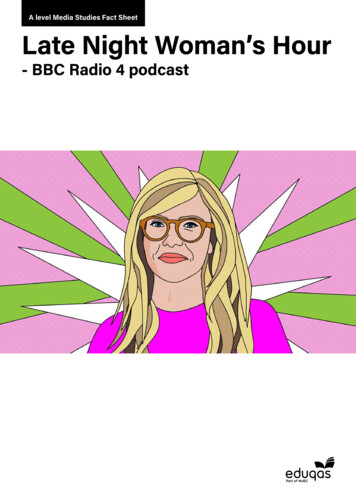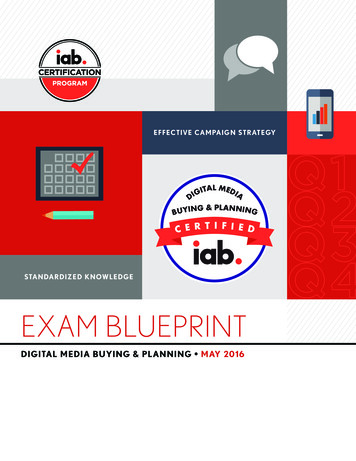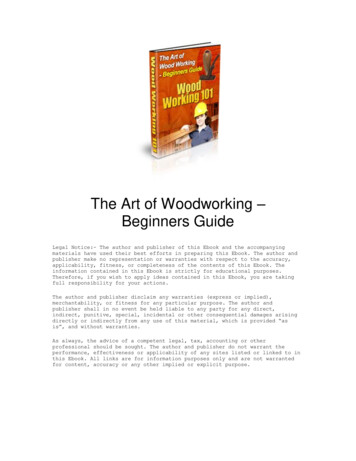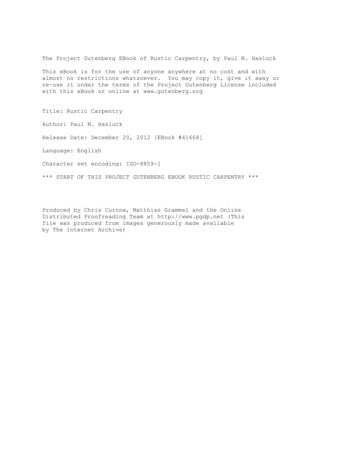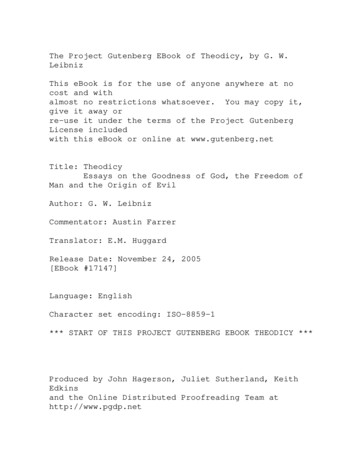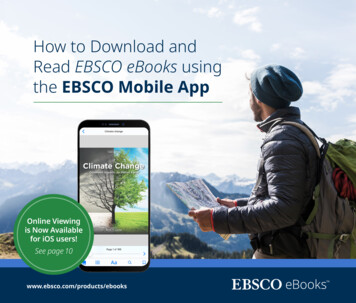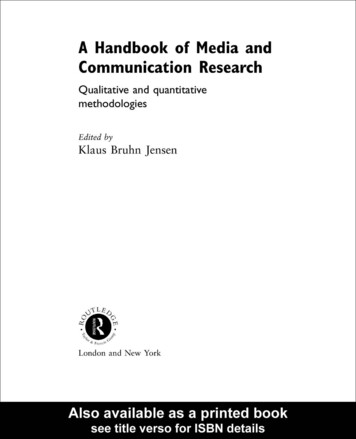
Transcription
94012345678950111A Handbook of Media andCommunication Research‘This Handbook takes on a full range of communication research approaches with an intelligence, skill, and agility not found in methodology texts.’Vincent Mosco, School of Journalism and Communication,Carleton University, Canada‘A Handbook of Media and Communication Research presents an excellent overview of andintroduction to the concepts and elements within major quantitative and qualitative researchprocesses.’Marit Bakke, Department of Media Studies, University of Bergen, Norway‘An authoritative, stimulating and rigorous survey of diverse research traditions in media andcommunications. The emphasis on identifying the potential for convergence across these traditions is both original and welcome.’Sonia Livingstone, London School of Economics and Political ScienceA Handbook of Media and Communication Research presents qualitative as well as quantitative approaches to the analysis and interpretation of media, covering perspectives fromboth the social sciences and the humanities. Combining practical approaches and theoretical concerns, the Handbook offers a comprehensive review of earlier research and a set ofguidelines for how to think about, plan and carry out studies of media in different socialand cultural contexts.The Handbook comprises three main elements: a historical account of the development of key concepts and approachesa systematic section covering media production, texts and audience as well asthe wider social, cultural and global contexts of media, and the changing role ofcomputer-mediated communicationa practical element taking readers through the stages of the research process as carriedout in student projects.Written by internationally acknowledged specialists in each area and supported throughoutby keywords, up-to-date references and graphic models, the Handbook will be a standardreference work for students and researchers in the field of media, communication and cultural studies. Contributors include: Barrie Gunter, Stig Hjarvard, Klaus Bruhn Jensen, PeterLarsen, Amanda Lotz, Graham Murdock, Horace Newcomb, Paddy Scannell, Kim ChristianSchroder, Gaye Tuchman.Klaus Bruhn Jensen is Professor in the Department of Film and Media Studies, Universityof Copenhagen and Adjunct Professor at the University of Oslo. His previous publicationsinclude A Handbook of Qualitative Methodologies for Mass Communication Research(coeditor, Routledge, 1991) and News of the World: World Cultures Look at TelevisionNews (editor, Routledge, 1998).
A Handbook of Media andCommunication ResearchQualitative and quantitativemethodologiesEdited byKlaus Bruhn Jensen GEROLEUT DlouyTaorp 12345678950111& F r n cis GarLondon and New York
First published 2002by Routledge11 New Fetter Lane, London EC4P 4EESimultaneously published in the USA and Canadaby Routledge29 West 35th Street, New York, NY 10001Routledge is an imprint of the Taylor & Francis GroupThis edition published in the Taylor & Francis e-Library, 2002. 2002 Klaus Bruhn Jensen for selection and editorial;individual chapters to their authorsAll rights reserved. No part of this book may be reprinted or reproducedor utilised in any form or by any electronic, mechanical, or other means,now known or hereafter invented, including photocopying and recording,or in any information storage or retrieval system, without permission inwriting from the publishers.British Library Cataloguing in Publication DataA catalogue record for this book is available from the British LibraryLibrary of Congress Cataloging in Publication Datahas been applied forISBN 0–415–22514–0 (hbk)ISBN 0–415–22588–4 (pbk)ISBN 0-203-465105 Master e-book ISBNISBN 0-203-773349 (Glassbook Format)
94012345678950111ContentsList of illustrationsNotes on contributorsPreface1Introduction: the state of convergence in media andcommunication researchKlaus Bruhn Jensenviiixxi1PART 1HISTORY: SOURCES OF MEDIA AND COMMUNICATIONRESEARCH2The humanities in media and communication researchKlaus Bruhn Jensen153Media, culture and modern times: social science investigationsGraham Murdock40PART 2SYSTEMATICS: PROCESSES OF MEDIATED COMMUNICATIONMedia organizations4The production of media fictionHorace Newcomb and Amanda Lotz625The production of newsGaye Tuchman786The study of international newsStig Hjarvard91
viContentsMedia texts7Discourses of factKim Christian Schrøder8Mediated fictionPeter Larsen98117Media audiences9Media effects: quantitative traditionsKlaus Bruhn Jensen13810Media reception: qualitative traditionsKlaus Bruhn Jensen156Media contexts1112Contexts, cultures and computers: the cultural contexts ofmediated communicationKlaus Bruhn JensenHistory, media and communicationPaddy Scannell171191PART 3PRACTICE: SCIENTIFIC APPROACHES AND SOCIALAPPLICATIONS13The quantitative research processBarrie Gunter20914The qualitative research processKlaus Bruhn Jensen23515The complementarity of qualitative and quantitative methodologiesin media and communication researchKlaus Bruhn Jensen16254The social origins and uses of media and communication researchKlaus Bruhn Jensen273ReferencesIndex294326
9.19.29.39.410.110.210.311.111.211.311.411.5Media in the structuration of societyTime-in culture and time-out cultureA model of social spheresThe stages of communicationThe levels of communicationA model of media, communication and cultureAn anatomy of media and communication researchA brief chronology of human communicationThe hermeneutic circleThe process of semiosisTwo levels of significationFour models of meaningThe news organization in a field of social forcesSources and news media as interconnected organizationsFour approaches to the study of international newsDimensions of critical discourse analysisComparison of different approaches to qualitative discourse analysisThe actant modelA model of narrative communicationEight levels of narrationThe visual code of television newsThe ‘stages’ of mediated communication, as defined by audience researchtraditionsExamples of differential rates of the diffusion of innovationsDimensions of campaign objectives and effectsChart of values among Danish respondents according to RISC principles (1995)Milestones of media and communication researchTwo varieties of reception studyThree flows of media useThree media flows in and between countriesThree types of interactivityFour modes of communicationHorizontal and vertical intertextualityThree levels of 30131139141147153157166169175185185187189
15.215.315.415.516.1Six prototypical empirical methodsTypes of validityAdvantages and disadvantages of different forms of survey administrationThe normal distribution curveThe role of language in qualitative methodologiesExamples of documents relating to media production and receptionThree variants of qualitative data analysisTwo paradigms of social and cultural researchSix levels of empirical researchDimensions of validity and reliabilityThree domains of reality, incorporating three types of phenomenaEmpirical microcosms, theoretical macrocosmsTypes of media research 3PLATES7.1 BP advertisement8.1 The introduction to The Big Sleep8.2. Bellour’s (1973) shot-to-shot analysis of a segment from The Big Sleep112122124TABLES7.1 Representation of protagonists on Review of the Year 1998, BBC1 199813.1 Summary of a regression analysis for variables predicting four measures ofhomicide newsworthiness101234ANALYSIS BOXES4.17.17.29.112.113.113.214.116.116.2Field visit to the production set of Any Day Now (1999)Content analysis of Review of the Year 1998, BBC1 1998Discourse analysis of advertisement for BPCorrespondence analysis of living conditions, lifestyles and media useHistorical research on archival dataSurveys and experiments compared: the case of cultivation researchTesting for statistical significance: chi-squareDiscourse analysis of qualitative interview dataThe signs of scienceTen rules for empirical student projects70101112153203229233249275291RESOURCE BOXES1.112.116.116.2General reference works and journalsNational and international varieties of media studiesHistories of media and communication research as a fieldKey studies and reference works for individual media3190280288
12345678950111ContributorsBarrie Gunter is Professor of JournalismStudies and Director of Research, Departmentof Journalism Studies, University of Sheffield.He is a chartered psychologist who has workedin the media sector as an audience researcherand has written 40 books and around 200 otherpublications on a range of media, marketing,and psychological topics.Stig Hjarvard, Ph.D., Professor, Departmentof Film and Media Studies, University ofCopenhagen. Head of the research program‘Global Media Cultures’ (http://www.global.media.ku.dk). Recent books are Internationaletv-nyheder [International TV news] (1995),Tv-nyheder i konkurrence [TV news in competition] (1999), Audiovisual Media in Transition(co-edited with Thomas Tufte, Sekvens, 1998)and News in a Globalized Society (editor,2001).Klaus Bruhn Jensen is Professor in the Department of Film and Media Studies, Universityof Copenhagen, and Adjunct Professor at theUniversity of Oslo. His work has addressedinterdisciplinary theories and methodologieswithin media studies, with a special emphasison reception analysis. Earlier publicationsinclude A Handbook of Qualitative Methodologies for Mass Communication Research (coeditor, 1991) and News of the World: WorldCultures Look at Television News (editor,1998). His current work focuses on computermediated communication, and its implicationsfor the field of ‘media’ and ‘communication’research.Peter Larsen, Professor at the Department ofMedia Studies, University of Bergen, Norway.He is the author of books and articles on semiotics, rhetoric, music in the visual media,textual analysis, and text theory in connectionwith film, television, and other forms of visualcommunication.Amanda D. Lotz (Ph.D., University of Texas atAustin) is a Mellon postdoctoral fellow andinstructor in the Program in Film and MediaStudies and Program in American CultureStudies at Washington University in St. Louis.Her research focuses on the representation ofwomen and feminism on television, with attention to emerging feminist theories such as postfeminism and third-wave feminisms, and theU.S. institutional environment of the postnetwork era.Graham Murdock graduated from the LondonSchool of Economics and went on to doresearch at the Centre for Mass Communications Research at Leicester University, beforejoining the interdisciplinary department ofSocial Sciences at Loughborough in 1990. Hehas been a visiting professor at the Universitiesof Bergen, Brussels, California, Mexico City,and Stockholm, and his work has been translated into thirteen languages. His most recentbooks include, as co-author, Researching Communications (1999), and as co-editor, Television Across Europe (2000).Horace Newcomb is Lambdin Kay Distinguished Professor and Director of the PeabodyAwards Program at the University of Georgia,
xContributorsand was, until recently, the F. J. Heyne Centennial Professor in Communication at theUniversity of Texas at Austin. He is co-author,with Robert S. Alley, of The Producer’sMedium (1983). He is also author of TV: TheMost Popular Art (1974), editor of six editionsof Television: The Critical View and editor ofThe Museum of Broadcast CommunicationEncyclopedia of Television (1997).Paddy Scannell is Professor and Head ofResearch in the School of Communication andCreative Industries at the University of Westminster. He is a founding editor of Media,Culture and Society, author of Radio, Television and Modern Life (1996), and co-author,with David Cardiff, of A Social History ofBritish Broadcasting, 1922–1939 (1991).Kim Christian Schrøder is Professor of Communication at Roskilde University, Denmark.His research has dealt with discourse analysisand reception analysis of advertising and televised serial fiction. He has published widely onthe theoretical and methodological aspects ofqualitative audience research. His currentresearch deals with political discourses and themedia in a combined text/audience perspective.Gaye Tuchman is Professor at the University ofConnecticut, and has specialised in researchwithin the Sociology of Culture, Gender, andTheory. She is the author of many publicationsin these areas, such as Making News (1978),Edging Women Out: Victorian Novelists, Publishers, and Social Change (1989, co-author)and a contribution to the first edition of Handbook of Qualitative Research (1994). Currentresearch interests include special education andinvisible differences in children.
12345678950111PrefaceThis book covers the state of media and communication research – its development, presentstatus, and future potential. It is addressed tostudents, researchers and media professionalsseeking an in-depth treatment of the field.In recent years, media studies have gonethrough a process of convergence betweensocial sciences and humanities, quantitative andqualitative approaches. This book presents thediverse theoretical sources of current mediastudies and provides examples of differentresearch techniques. It also outlines the profileof this academic field, as it relates to the rest ofthe academy and to contemporary society.To serve as an accessible yet comprehensivehandbook, the volume includes a number offeatures: examples of the main types of media analysis, including production research, textualanalysis and audience studies; reviews and comparisons of the centraltraditions of theory and methodology; resources and extensive references for theplanning of empirical research projects; keywords and cross-references; abstracts, as well as figures and tables summarizing the main points of each chapter.In preparing the volume, I have had the privilege of cooperating with a number of competent and generous people. First of all, I amgrateful to the contributors to the volume, whoagreed to join me in the process of developing this reference work. Simultaneously, I havebenefited from many discussions with, andsuggestions from, colleagues at the Universityof Copenhagen and at the University of Oslo.While drafting the text, I have drawn muchinspiration as a member of two research programs: Global Media Cultures (1999 to 2001)at the University of Copenhagen (http://global.media.ku.dk) and DIWA (1999 to 2003)(Design and use of Interactive Web Applications – http://www.diwa.dk), a joint projectof four Danish universities. Svein Østerud hasbeen a continually constructive partner indebates on methodology for more than tenyears. Special thanks are due to Peter Dahlgrenand Søren Kjørup who both took the time toread and offer constructive criticisms on earlierdrafts of several chapters.My deepest thanks go to Ghita – my wife,my friend, and a real human being.Klaus Bruhn JensenCopenhagen, April 2001NOTEKey concepts and discussions of key terms areindicated by a marginal note beside their firstplace of mention in the text.The symbol 䉳 in the text indicates a crossreference to the preceding text which can befound below.The symbol 䉴 at the foot of a column indicates the cross reference linked to its mentionin the above column.While the publishers have made every effort tocontact copyright holders of material used, theywould be grateful to hear from any they mayhave been unable to locate in order to rectifyany omissions in subsequent printings of thisvolume.
123456789501111IntroductionThe state of convergence in mediaand communication researchKlaus Bruhn Jensen a reassessment of the field with reference to the three concepts of media, social structure, and humanagencya distinction between media of three degrees: speech, technologically reproduced communication, andcomputer-mediated communicationa comparison of culture in the narrow sense of aesthetic works and in the broad sense of a whole way oflifea definition of modern media as institutions-to-think-witha presentation of a communication model which integrates traditional transmission and ritual modelsoutline of the handbook, its elements, and interrelations.MEDIA, STRUCTURE AND AGENCYAt least since the self-consciously titled ‘Fermentin the Field’ issue of the Journal of Communication (1983), there has been a recognitionwithin media and communication research thatthe diverse theoretical and methodologicalsources of the field, in the social sciences and inthe humanities, hold a significant potential forconsolidation through integration. Toward thisend, one comprehensive conceptual frameworkis available in the work of Giddens (1984), evenif its particular relevance for media remains tobe developed (for assessments, see Bryant andJary 1991; Held and Thompson 1989). Hisstructuration theory is, first and foremost, ameta-theory which seeks to move both empirical and theoretical studies beyond certainentrenched dualisms from more than a centuryof social and cultural research, including subjectivist or objectivist, interpretive or causal,hermeneutic or materialist, micro- or macroapproaches to society and culture.The key to Giddens’ integrative move is thenotion of a ‘duality of structure,’ which defines duality ofhuman agency and social structure each as an structureenabling condition of the other. Human agency,accordingly, is not the manifestation of any freewill, as exercised by individuals or collectivities, nor is social structure a set of external constraints on their action. Instead, social subjectsand social systems must be seen as continuallyreproducing and, to a degree, reforming eachother, and they interact, not as abstract principles, but in concrete practices and contexts:‘structure exists . . . only in its instantiations insuch practices and as memory traces orientingthe conduct of knowledgeable human agents’(Giddens 1984: 17). To exemplify, the pressconsists simultaneously of its structural properties – its economic, legal, technological, aswell as cultural-conventional permanence – andof the myriad activities of journalists, advertisers, regulators, and audiences who both maintain and contest these properties. Like othersocial institutions, the press, and the media as
cursiveconsciousnessthe unconscioussuch, are not only reinterpreted, but re-enactedon a daily basis.In order to explain how some measure ofstability emerges from social flux, structurationtheory places special emphasis on the conceptof reflexivity. (For additional discussions ofreflexivity and the meaning–action nexus, seeBeck 1999: 109–132; Bourdieu 1977.) Giddensdescribes reflexivity as a general interpretivefaculty that enables humans to ascribe meaning to their transactions with others, both inone’s most intimate relations and in encounterswith institutions of political or religious authority. Importantly, this meaning may not bearticulated in any explicit form, neither in discourse nor even in consciousness. ‘“Reflexivity”should be understood not merely as “selfconsciousness” but as the monitored characterof the ongoing flow of social life’ (Giddens1984: 3).The point is that reflexivity orients peopleand allows them to act, to go on, and that itwould be possible for them, as a rule, to justifytheir actions if they were challenged. In mostcases, however, people will simply go abouttheir business, and will be able to coordinate itwith that of others to a remarkable degree, byrelying on shared, implicit assumptions, whatGiddens terms their practical consciousness.This is in contrast to discursive consciousness,a focused form of intentionality, that can bemobilized in response to one’s own doubts orto alternatives advanced by others. (The thirdelement of Giddens’ model of consciousness isthe unconscious, which is largely comparableto its original Freudian version.) Listening tothe radio, for instance, often serves the practical purpose of monitoring a morning routineuntil it is time for members of the householdto leave for work or school, but a particularnews item about public transport or road conditions may shift the listeners’ attention into adiscursive key because this might requireactions out of the ordinary.The media play a special role, both as meansof reflexivity and as sources of social structuration. Giddens recognizes this, in part, byone of his central distinctions between technologically mediated and non-mediated socialinteraction or, in his terminology, system inte-gration and social integration. In contrast tosocial integration, which refers to local, faceto-face interaction, system integration is definedas ‘reciprocity between actors or collectivitiesacross extended time–space, outside conditionsof co-presence’ (Giddens 1984: 377). Oneoutcome of such mediated interaction is a ‘disembedding’ of people from their traditionalrelations and environments, and a ‘re-embedding’ into different social formations. Thereference is primarily to the modern era, whichis characterized by the coordination of economic, political, and cultural activity acrossgreat distances and time differences, whatGiddens calls ‘time–space distanciation,’䉳 increasingly on a global and round-the-clockscale (see also Giddens 1990, 1991). Whilesocial integration is performed, above all, byoral communication, system integration hasdepended on shifting technologies and institutions of communication, from handwrittenadministrative and accounting systems tobroadcasting and beyond.Nevertheless, Giddens has paid surprisinglylittle attention to the media as a condition ofmodernity. ‘Signification,’ including its technologically mediated forms, is one of his threedimensions of social systems, the other twobeing domination, namely the exercise of powerthrough political and economic institutions, andlegitimation as exercised typically by legal institutions (Giddens 1984: 29). But the pervasivecommunicative aspects of each of these, and ofpractically any type of social action, have remained a blindspot in Giddens’ work (see Jensen1995; Silverstone 1999; Thompson 1995).A meta-theoretical framework that treatscommunication not as incidental, but as a necessary constituent of social life, is relevant notjust to the media field, but to theories of societyand culture as such. In order to move beyondthe lingering dualism of ‘the duality of structure,’ it is helpful to introduce a third categoryof medium, on a par with agency and structure.In a historical and anthropological perspective,media include spoken and body language,scratch notes and government administrations,䉴 time–space distanciation, disembedding, and reembedding – Chapter 11, p. 182
Media of three 567894012345678950111RESOURCE BOX 1.1 GENERAL REFERENCE WORKS AND JOURNALSThe following texts provide general resources and overviews for the field of media and communication research. The titles cover different traditions, as indicated, and include qualitative aswell as quantitative methodologies.Encyclopedia Barnouw 1989 – a multi-volume comprehensive reference work on most aspects ofcommunication, including mediated and interpersonal formsWatson and Hill 1999 – a concise reference work.Abstracts Communication abstracts – a listing with abstracts and keywords of current research.Handbooks and textbooks McQuail 2000 – a solid introduction to positions in the field, with a relative emphasis onsocial-scientific traditionsBerger and Chaffee 1987 – a somewhat dated, but still useful overview summarizing workdefining communication studies as a ‘science’Jensen and Jankowski 1991 – an overview delineating the contributions of qualitativeresearch, both social-scientific and humanistic, to the media fieldLindlof 1995 – a reference work emphasizing the interpretive legacy in social science andits relevance for qualitative empirical studies.Journals Journal of Communication – since the mid-1970s a central journal in the field,accommodating both quantitative and qualitative, administrative and critical workCommunication Theory – a more recent addition to the field, covering interpersonalcommunication as well, and with important theoretical contributions to the media fieldCritical Studies in Media and Communication and Media, Culture and Society – tworepresentatives of a primarily critical as well as interpretive strand of media researchJournal of Broadcasting and Electronic Media and Journalism and Mass Communication Quarterly– two representatives primarily of the quantitative, American mainstream of media researchScreen – one of the journals focusing on film (and television), which also includescontributions with implications for the wider fieldNew Media and Society – one of several journals currently shaping the area of computermediated communication.broadcasting and the Internet. Their commoncharacteristic is that they serve to orient humanagency as it enacts social structure, partly at thelevel of practical consciousness and everydayroutines.MEDIA OF THREE DEGREESThe growth of computer-supported communication has recently presented ‘mass’ mediaresearch with a need to reconsider its centralobjects of study. Computers can integrate previous media technologies in a single metamedium (Kay and Goldberg 1999 [1977]: 112);to a degree, computers can also simulate embodied, interpersonal communication. To indicate the scope of this handbook, it is useful todistinguish three prototypes of media:1 Media of the first degree. The biologicallybased, socially formed resources that enablehumans to articulate an understanding of3
4Introductionreality, for a particular purpose, and to engagewith others in communication about it. Thecentral example is verbal language, or speech,but additional ones include song and othermusical expression, dance, drama, painting,and creative arts generally. Such media dependon the presence of the human body, and operatein local time–space, often relying on comparatively simple, mechanical techniques such asmusical instruments and artistic and writingutensils as constitutive elements. (Handwritingpresents a special case, which has supportedcomplex historical communication systems.However, its comparatively inefficient forms ofreproduction and distribution arguably madethis a transitional cultural form (Meyrowitz1994: 54).)2 Media of the second degree. The technicallyreproduced or enhanced forms of representation and interaction which support communication across space and time, irrespective of thepresence and number of participants (Benjamin1977 [1936]). Early modern examples includedthe standardized reproduction of religious andpolitical texts through the printing press(Eisenstein 1979). In radio talkshows, conversation took on new forms, just as actingstyles were adapted to cinema and television.Thus, media technologies have performed a‘re-embedding,’ both of the media of the firstdegree and of people in relation to distantothers, issues, and arenas.䉳3 Media of the third degree. The digitallyprocessed forms of representation and interaction which reproduce and recombine previousmedia on a single platform. The central currentexample is the networked personal computer.䉳This ‘interface’ is likely to change substantiallyas the technologies are adapted further tothe human senses, and integrated into bothcommon objects and social arrangements. Incertain respects, humans are media; in certainrespects, media can substitute the social rolesof humans.Agency Discursive consciousness Practical consciousness the UnconsciousStructure Resources– Allocative (Re: objects, goods, materialphenomena)– Authoritative (Re: persons, actors) Rules (Re: meaning and sanctioning of socialconduct)Media Media of the first degree Media of the second degree Media of the third degreeFigure 1.1 Media in the structuration of societyFigure 1.1 brings media into a revised conceptual table of structuration theory. WhereasGiddens (1984: 374) has linked discursiveconsciousness with verbal expressions only,it remains important to examine how the fullrange of media relate to different levels ofconsciousness and forms of culture. Moreover,particularly in contemporary society, media areamong the central social ‘resources’ in Giddens’terms, just as they are vehicles of many of the‘rules’ that inform social interaction. This handbook focuses on media of the second degree;reviews media of the third degree as a growingfield of social activity and study; and includesdiscussion and references on media of the firstdegree, as they relate to the technologicalmedia. Each of these media types facilitatessocial structuration in specific ways, and theydo so by participating in the production andcirculation in society of meaning, which accumulates as culture.THE DUALITY OF CULTURE䉴 history of media and communication – Chapter 12Like studies of society, research on culture hasbeen divided by dualisms, with two dominantdefinitions criss-crossing the humanities andsocial sciences.䉳 On the one hand, culture has䉴 computer-mediated communication – Chapter 11,p. 182䉴 the concept of culture – Chapter 11, p. 172
Duality of 567894012345678950111culture asaestheticrepresentationculture associal practicetime-outculturetime-inculturebeen conceived as representations of reality –texts and other artefacts – which express someprivileged insight, often in an arena such as amuseum that is separate in space an
1.4 The stages of communication 8 1.5 The levels of communication 9 1.6 A model of media, communication and culture 10 1.7 An anatomy of media and communication research 11 2.1 A brief chronology of human communication 18 2.2 The hermeneutic circle 21 2.3 The process of semiosis 24 2.4 Tw





